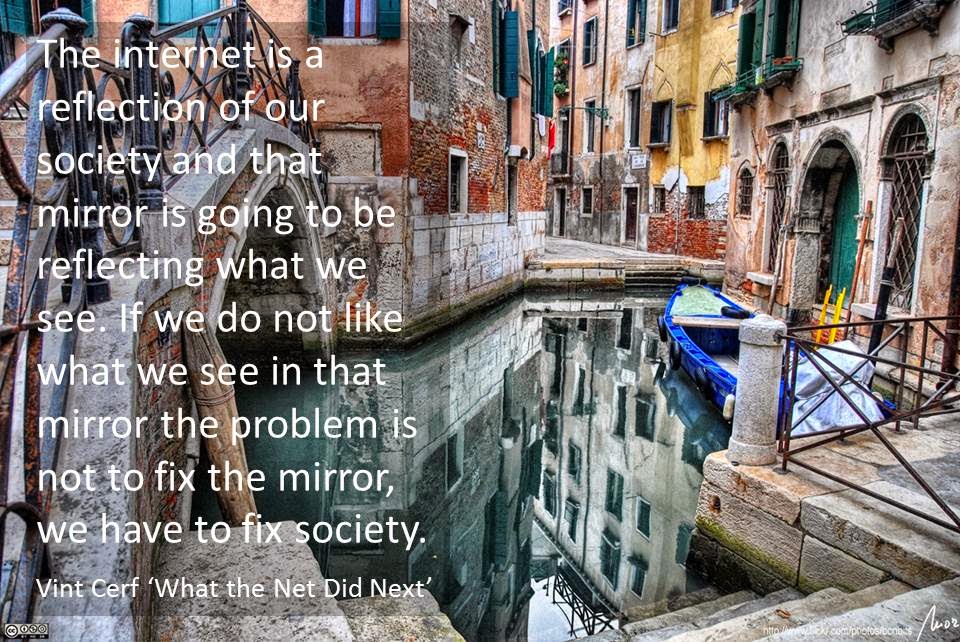
 |
| creative commons licensed (BY-SA) flickr photo by brizzle born and bred: http://flickr.com/photos/brizzlebornandbred/4934882110 |
In a recent ICT committee meeting, one of the participants made the remark that the digital revolution has failed to deliver all that it supposedly promised. Having been a part of the YVeLC pilot program almost ten years ago which focused on the potential of 2:1 laptops, it has been interesting seeing the changes that have occurred since that time. In a conversation with +Catherine Gatt, this is the list of reasons that we came up with as to why the digital revolution has failed to be the saviour that so many said it would be.
Failure to Invest
The government, both state and federal, has invested a lot over the last ten years. Whether it be providing Internet for students, WiFi access in schools, support in regards to servers and switches, as well as devices for students. In addition to this, the state government Victoria made a big investment with the now defunct Ultranet, a learning platform that was supposed to be the intermediary between staff, students and parents. The big question however is whether it has been enough?
For even though the government has provided Internet access, it cannot always be trusted due to insufficient bandwidth and tendency to drop-out. This has led to some schools investing in their own lines, creating a new culture of equity surrounding access. In addition to this, even though the government provides state schools with WAPs and other such infrastructure support, there are schools who find this hardware insufficient for their needs. Therefore, although the government has made significant investments, the question is whether it could have been done better?
I will never forget sitting in the meetings in regards to the Ultranet being told how many thousands of dollars that it would cost to make even the most minuscule of changes. Maybe instead of investing so much money developing a new product, the government could have invested more in regards to support and infrastructure, letting schools choose their own solutions, whether that be Google Apps for Education and Edmodo or some other combo and simply providing support in the form of coaches with the implementation.
Lack of Leadership and Guidance
Another point of confusion relates to the leadership and guidance surrounding the support of ICT in schools. I cannot think of another area in education with so many competing positions and job titles. One school has an ICT Co-ordinator, another has an eLearning Coach, while another a 21st Century Learning Coach. Then you have some schools who have nothing? You just need to look at the various posts on the matter to get a feel for the matter:
Each post encompasses the topic in its own way, but never completely, for how can it when the area itself is still largely undefined.
Whereas in the past the person in the ‘role’ might have worked with a technician to manage the moderate school network and maintain a few computer rooms, now it has expanded to include anything and everything. Spanning pedagogical practice to administering various systems to exploring areas of technological innovation.
Unlike other areas, such as literacy and numeracy, which are relatively settled or at least people feel that they can comfortably define them, ‘technology’ offers something that some just aren’t sure about. For how do you really measure the success of technology in schools? Instead, the management and leadership in this area is at times left to those with a passion and interest, therefore sometimes limiting the scope to change possible in some educational settings.
Fear of the Unknown
Attached to the confusion over leadership is the culture of fear often associated with technology. One of the biggest changes to education, I would argue, in the 21st century has been the attempt to reposition the place of the teacher away from being the one at the front of the room, to becoming a facilitator whose prime focus is to amplify the thoughts and ideas of the other learners in the classroom. With this comes the move from teacher-as-authoritarian to teacher-as-lifelong learner. For some, this shift is easier than others.
In the heyday of technology in school, the message preached was that students knew more, therefore let them run the show. The problem with this is that instead of being a facilitator, the teacher became a ghost in the room, someone largely absent, unsure about exactly what was going on, living in good faith.
To me, palming responsibility off to students is not stepping to the side, this is stepping out of the classroom. What eventuates in this environment is a culture of fear where because you never really know what the students are doing, you jump at every flash and bleep that may occur.
I understand that as a teacher you will never always ‘know’, but to me teachers have a duty of care unto themselves, to lifelong learning – to at least try and understand in order to support students as they come up against issues, rather than curse that technology will be the death of us all.
With this, teachers need to embrace the unknown and with the students in mind, model how the solve problems. Sometimes it is through such moments of honesty that everyone learns the most.
Technology as the Answer
One of the things associated with technological fear is the expectation that somehow technology will be the panacea to all of the modern ills. Too often teachers expect technology to somehow change what they do without them changing any point of their own practise.
I have seen too many examples where teachers have introduced technology into the classroom as if it were a solution in itself. Then as soon as there is a hiccup, they baulk and revert to what John Goh describes as our default position. The problem with this is that technology is always doomed to fail if it is not linked to pedagogy and purpose.
In the end, technology is not the magic cure, rather it is how it is used that has the potential to have meaningful change. It is one cog in the complex construct that is 21st century learning. For it is through the sum of many parts that students learn. (See my post ‘Sum of the Parts Different to the Whole‘ for a better explanation.) The reality is, you just need to look at the work of John Hattie and you soon realise that the biggest point of influence in the classroom is the teacher themselves. That does not mean that we should simply rid ourselves of technology and focus on the teacher, instead the focus should be on how technology can be used to further practises, such as collaboration, communication and critical thinking
Another Thing to Fit
One of the big changes in regards to curriculum over the last few years has been the advent of interdisciplinary strands, such as thinking and interpersonal learning. In addition to this, the curriculum has been made even more explicit, especially for primary school. For example, whereas in the past students in Early Years had to assess against ‘the Humanities’. this has been split up within the National Curriculum and made more explicit. In this environment, ICT and technology becomes another thing to consider in an already cluttered curriculum.
ICT as a Subject
Seeing ICT as another thing ‘to do’ misunderstands its place and purpose. Instead of seeing it as an integral part of every lesson, ICT is too often seen as something done with the ICT teacher. Sadly, what should be done in ‘ICT’ is something more akin to computer science. However, it has sadly come to be seen as the time when students get their dose of technology for the week, therefore absolving any requirement to report against it elsewhere. For as we all know, students only engage with literacy in English classes, don’t they?
As +George Couros has stated, something is missing when we treat technology as an event. To achieve meaningful change, technology needs to be at the point of instruction. It is then that the potential to redefine the way students learn can truly occur.
In his book, ‘The Five Minute Teacher’, +Mark Barnes suggests introducing different applications and tools on a regular basis to help student build up a toolkit of possibilities. In this scenario, students then build up an array of possibilities so that when they are given choice in regards to working in a collaborative manner or communicating an idea they can make an informed choice. ICT is then an aide to learning, not the actual focus.
Outdated
Whether it be the choice of tools, applications and programs or operating systems themselves, the world does not stand still. Things are always evolving. Ten years ago the school I had kept a small collection of cameras in the library, now just about every teacher let alone student has one embedded in some sort of device, whether it be a tablet, smart phone or laptop. With this change means that devices like Flipcams have become obsolete. Although the hardware may still function and would probably have cost quite a bit to buy, their quality and ease of use has become superseded.
One of the traps that teachers often get caught teaching the tool as opposed to emphasizing on the purpose. In focusing on skills, it no longer matters what tool or application is used, instead the focus becomes on why it is being used.
Change as a Mindset
Education has evolved during the last few years, sometimes though we just don’t recognize all the subtle changes. Maybe what we have is the revolution that we were promised and instead the problem is our inability to see it. I am reminded of +Chris Betcher‘s closing keynote at Melbourne Google in Education Summit 2013 where he explained that in many respects what happens in schools has not necessarily changed. Instead, the friction has been taken away, meaning that what may have taken hours in the past, can now be done in seconds.
As I stated in a previous post ‘Looking Back to Look Forward‘, it is easy to identify our failings, to think that nothing has changed, but if we stop and reflect for a moment we often find that a lot has changed. The challenge then is to change the way we look at such things, rather than change the things themselves.
What About You?
These are my reflections, what about you? Have I missed something? Do you disagree? Is your system of education different to the one I have portrayed? Is this specific to Australia or are these issues global? What do you think needs to happen now? I would love to know. Please leave a comment below.
If you enjoy what you read here, feel free to sign up for my monthly newsletter to catch up on all things learning, edtech and storytelling.












